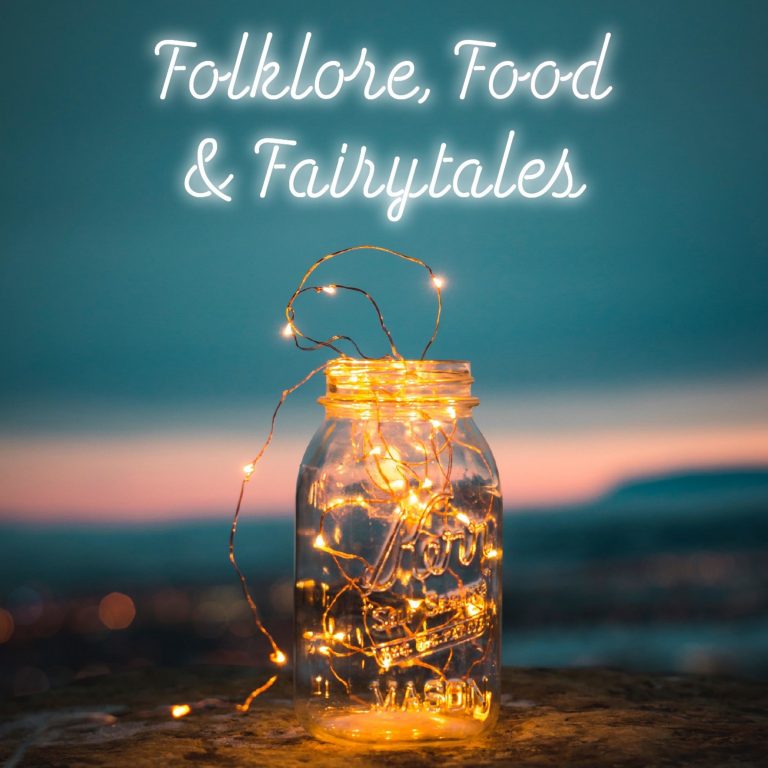In which we discover that a hero should keep his promises, that you should wait to get home before snacking, your father isn’t always right and a delightful Hungarian cheese puff can save your life.
In which we discover that a hero should keep his promises, that you should wait to get home before snacking, your father isn’t always right and a delightful Hungarian cheese puff can save your life.
This podcast also has a terrifying ogre, three mysterious old ladies, three wonderful yet terrifying dogs, three miraculous napkins, a generous employer, cakes, a slightly inconvenient wife, and many herds of animals. Warning: this podcast also contains nuts.
The story in the podcast is based on Eisenkopf from Andrew Lang’s Crimson Fairy Book
The recipe can for Sajtos Pogácsa – Hungarian Cheese Puffscan be found here.
You can find The Prince of Transylvania’s Court Cookbook and other resources in Further Reading

Lost in Translation
I found this story exceptionally interesting for so many reasons. It is a Hungarian folk tale although a German version can be found as “Eisenkopf” in Ungarische Volksmärchen by Elisabet Sklarek translated from the Hungarian. I first the read the English version in the Crimson Fairy Book by Andrew Lang, translated by Leonora Lang. Andrew Lang is very clear that although his name in on the cover, much of the work of finding stories and translating them was done by other people, quite often by his wife.
A Handy History
The story has a lot of elements that are present in various European storytelling traditions but is only to be supposed that a country which sits so centrally would have a storytelling heritage as mixed as its food culture. There will be more of that later. A brief simplistic history of Hungary is probably handy here. Hungary was founded in 895 from a previously nomadic people, the Magyars and moved from Paganism to Christianity, officially becoming a country on Christmas Day 1000.
Hungary flourished for the next 300 years apart from a brief 2 year Mongol invasion. In 1396 the Turkish Ottoman Empire starting moving in on Hungary and eventually occupied large swathes of the country for around 200 years, leaving Transylvania as a separate principality and only Northern and Eastern Hungary ruled by the Hapsburgs.
The Trouble with Hapsburgs
The Hapsburgs eventually expel the Ottomans from Hungary and repopulated the uninhabited areas of the country with Romanians and Slovaks. The Hapsburgs reigned from 1699 to 1848, this was not without troubles and resulted in a War of Independence which began in 1848. The Hapsburgs were proclaimed dethroned by the new Hungarian parliament in 1849. Unfortunately the Russian Tsar and the Austrian Emperor were not going to stand for this sort of revolutionary behaviour and eventually the Hungarian army was forced to capitulate to the forces of both leaders.
This resulted in the dual monarchy of “Austria the empire, Hungary the kingdom”. In 1867 there were two capitals, two parliaments until the Austro-Hungarian monarchy was established. The first and second world wars were not good for Hungary and Communism behind the Iron Curtain curtailed some of its development. It became a democratic republic in 1990 after its first democratic general elections.
A Matter of Influence
You can imagine what an effect all these influences and its geographic position would have on the storytelling heritage of the country. Eisenkopf itself is a German name and it means Iron Head, strangely the reason for this wasn’t mentioned anywhere in the tale. There are other elements that indicate a mixed heritage: the three old women that assist bear a strong resemblance to the benevolent face of Baba Yaga and the three dogs with the descriptive names are a feature of German and Scandinavian storytelling. There are two different stories titled The Three Dogs, one German and one Swedish where three descriptively named dogs save their master and princesses. The Danish Tinderbox also has some similar elements.
Any Questions?
There are a lot of unexplained things that happen in this story. My first two questions are with Peter’s employment: if a year is only three days, why not stay another year and why doesn’t his very generous employer give him any warning about waiting until he got home before opening the nut. The only conclusion that I can come to is that there may have been something lost in translation from the original Hungarian to the German and then into English.
The third question I had was why request that Peter not get married? There doesn’t seem to be any point to it. Additionally why does this story go against nearly every other story that treats a promise as an unbreakable oath? Breaking his oath does at least cause Peter some problems and in his defence it is his father that wants him to break his oath, he had no intention of doing so. Peter is clearly a man of some honour as he has no intention of leaving his wife even after he finds that he has fallen in love with the golden-haired maiden.
Is it a Dog? Is it a Cake? No, its a Cheese Puff
The use of napkins to create a path through the protective fire is very interesting and yet another example how folktales use everyday objects to overcome supernatural barriers. The cakes which turn into dogs are another fascinating element and don’t seem to be replicated anywhere else that I can find. If anyone knows of any other incidents I’d be fascinated to hear of them.
A Brief Culinary History
So to food, Hungarian food is fabulous and researching this made me very hungry and desperate to go to a good Hungarian restaurant and/or visit Budapest. That is currently impossible so I have bookmarked several fantastic recipes I plan to try over the festive period. Anyway to go back to Hungarian food rather than my food dreams, Magyar culture has had a significant effect on Hungarian cooking. The nomadic lifestyle and the importance of livestock are reflected in the large amount of meat dishes as well as those that are traditional best cooked in a pot over an open fire. Excellent examples are Gulyás soup(goulash, literal translation – belonging to the cattleman), Pörkölt, a richer stew and Halászlé, a spicy fish soup.
As the people became less nomadic both renaissance and Neopolitan influences become noticeable in the late medieval period. New spices and aromatics were introduced like garlic, nutmeg, mace, saffron and ginger and the use of both fruit stuffings and fruit cooked with meat became more popular. It goes without saying really that these were introduced at in court and noble circles but the use did spread down through other social classes over time.
There are several medieval Hungarian cookbooks which show some wonderful dishes, thankfully three of them including The Prince of Transylvania’s Court Cookbook have been translated into English by kind food history enthusiasts and their supporters. You can find links to these in the Further Reading if you would like more information. The spices and fruit are very much in evidence as well as vinegar which is likely to have been wine vinegar as Hungary was also a wine producing country.
There has also been a Turkish influence due to the Ottoman invasions, most noticeably in the use of paprika and other chillies as well as stuffed peppers. Under Hapsburg rule, Austrian cooking methods and ingredients entered Hungarian cuisine. This is best demonstrated in the incredible range of beautiful, complex cakes and pastries available. Hungarian cuisine has also been influenced by the Balkan states around it.
All this is very much a quick tour through Hungarian food which is probably best summed up as vibrant melting pot as you would expect in a country in the middle of a continent, however this is very much anchored by the original Magyar cuisine. You might have noticed that I have ignored the Communist period, this is not a political choice its just that food shortages and a desire for uniformity did not do Hungarian food any particular favours.
A Savoury Cake? Life’s Disappointing Enough Gary
So to today’s recipe, I think its an excellent choice as there is both a historical and folklore basis for my choice: Pogácsa. This turf-cake, small round cake or scone is one of the oldest and most familiar baked good in Hungary. It was more commonly a sweet cake if the recipes in the medieval cookbooks are anything to go by but in modern Hungary it is more likely to be savoury. The most popular varieties are potato, butter, cheese and crackling but there are endless variations. The name comes from the fact that it was originally baked in the ashes of the fire, related via several languages to the Italian focaccia which comes from the Latin for hearth fire (focus).
This cake baked in the ashes of the fire appears in a lot of Hungarian folklore and tales as the item given to sons who are about to proceed on a journey quest. It is also the most likely type of cake that would have been given to Peter by the three elderly sisters if you follow that reasoning. I’m still unclear on why they would turn into dogs but I’ve decided to let that go.
Finally, Cheese Puffs
I’m a huge lover of a cheese scone myself (the British round version, not the strange triangular ones) so I thought that a cheese version of the Pogácsa would be the perfect thing to try. I found a wonderful recipe online and preceded to make them, they were wonderful but not quick. I promise at some stage I will provide another quick and easy recipe like the cheese toastie. There are several steps to the recipe but you can get on with other things between the stages and the results are definitely worth it. I haven’t adapted this recipe so I will just link to it directly: Sajtos Pogácsa – Hungarian Cheese Puffs
I should probably add a warning though, you will eat a lot of them whilst they are warm so don’t worry that you will have around 50 puffs. As you have so many no-one will even notice the cook’s reward that you snaffled in the kitchen. They freeze well like scones, just remember to pop them in the oven for a warm before serving. They would be perfect to serve alongside tiny warm sausage rolls as a snack with drinks. I wish I still had some now, I’m going to go and make cheese scones after this, they are a quicker fix for my warm cheese baked goods addiction.
Further Reading
The Crimson Fairy Book by Andrew Lang
Sklarek, Elisabet. Ungarische Volksmärchen. Einl. A. Schullerus. Leipzig: Dieterich, 1901 http://www.zeno.org/M%C3%A4rchen/M/Ungarn/Elisabet+Sklarek%3A+Ungarische+Volksm%C3%A4rchen/15.+Eisenkopf
Folk-lore and Legends, Scandinavian
The Prince of Transylvania’s Court Cookbook
Magyar étkeknek fözése
An Anonymous Late 16th Century Cookbook
If you want to read a little bit more about me, more information can be found here.
Image Credit: Image by Madeleine Lewander from Pixabay

